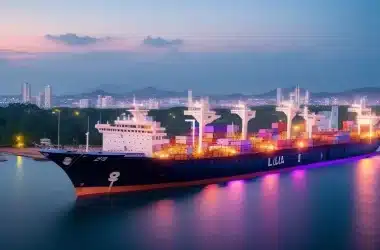Imagine driving on a bridge so long that it stretches over a mind-boggling 164 kilometers, connecting not just two cities, but five. And because of how long this bridge is, you could be driving on it for hours and still not see its end.
China’s Danyang–Kunshan Grand Bridge is the world’s longest bridge.
In fact, it’s so long that it required half a million tons of steel – enough to build 60 Eiffel towers. This $8.5 billion colossal feat of engineering is a sight to behold. But, what drove China to build such an ambitious project?
Why China Built it
China is known for being a country that doesn’t back out from a challenging megaproject, and even attempting to build structures that no other country has. We’ve previously covered how the country built the world’s first overwater train, as well as the world’s longest highway tunnel.
But, one of China’s most impressive projects to date is the Danyang–Kunshan Grand Bridge, the world’s longest bridge. Picture this: you live in the eastern coastal area of China and want to travel between two of the area’s major cities, Ningbo and Jiaxing. But, you quickly find out that this journey is four and a half hours long, and that’s if you’re lucky and don’t run into bad traffic.
Many Chinese citizens struggled with this, and the Chinese government recognized the problem and how hard it was to travel in the country’s eastern coastal area, so the first solution was to build the Hangzhou Bay Railway.
The Problem with a Traditional Railway
The region’s geography isn’t exactly helpful for building railway projects, with its rivers, lakes, canals, and lowland rice paddies. Not only that, but the rivers and lakes in the area amount to over 115 river channels, wider than 20 meters.
With this heavy amount of water in the region, constructing a railway would mean building several bridges and causeways, which can take a long time, as well as get very expensive. Additionally, the area’s soil is so soft and heavy with silt, which meant that building stable infrastructure, especially for a railway, on it would be extremely hard. Not only that, but this soft soil has attracted communities of farmers to live around it, and building a railway would displace these farmers and ruin their farmlands.
Danyang–Kunshan Grand Bridge
The Chinese government had to think of a solution that would allow it to build a fast and stable railway without turning the whole area upside down, and that’s where the Danyang–Kunshan Grand Bridge comes in.
By building an elevated bridge that includes a strong and high-quality railway line, as well as two long roads for people who prefer traveling with their cars, the Chinese government had found its solution. Since the bridge was lifted over 100 feet in the air and didn’t touch the soil or disrupt the local communities, it resolved all the issues associated with the proposed Hangzhou Bay Railway.
Not only that, but the bridge was brilliantly designed to not only defy earthquakes that frequently happen in the area, but also remain unwavering in the face of the strongest typhoons. It can even take a hit from a 300,000 ton ship without as much as a scratch.
With its strategic location in the Jiangsu province, the bridge connects China’s main financial hub, Shanghai, with the Ming dynasty’s national capital, Nanjing. This connection along the high-speed Beijing-Shanghai railway line, shortens the travel time to under five hours. As for commuters on China’s eastern coastal area, the trip between Ningbo and Jiaxing was reduced to just two hours.
The Danyang–Kunshan Grand Bridge quickly became a game-changer for commuters. This single project has significantly improved overall connectivity by linking the five cities of Danyang, Changzhou, Wuxi, Suzhou, and Kunshan.
The Construction
As you’d expect, construction of the world’s longest bridge was no easy feat. It began in April 2006, and finished when the bridge opened in June 2011. Completing the 164-kilometer bridge in just four years took the hard work of over 10,000 workers.
The state-owned China Road and Bridge Corporation, a major player in China’s civil engineering and infrastructure industries, built the bridge. It has also had a role in other megaprojects like the Beijing-Shanghai high-speed railway, and the Beijing Capital Airport Expressway.
The total project cost $8.5 billion, which works out to a staggering $51 million for each mile. Designed as a viaduct bridge, which means that it consists of a series of arches, piers and columns supporting a long elevated railway or road, the bridge rises and falls with the region’s different terrain.
To achieve this, builders used more than 4,000 prestressed concrete beams, each reinforced with high tensile steel wires. The prestressing process involved the tensioning of the steel wires before pouring the concrete, and this was very important in order to provide the required compressive forces to counter potential tensile stresses. This allows the bridge to withstand heavy loads, like the weight of the railway and passing cars.
Earthquakes & Typhoons
To address the high risk of earthquakes in the region, the construction team used advanced earthquake resistance engineering techniques. Base isolators absorb much of the earthquake’s impact by moving and stretching under pressure. Elastomeric bearings provide extra support to the concrete structures and sliding plates in the bridge’s foundations. As for the rail tracks in the middle of the bridge, they include expansion joints that help the passing trains adapt quickly to the ground movement during tremors.
Another highlight of the bridge’s design is its ability to withstand strong typhoons. This was made possible using corrosion-resistant steel painted with protective coatings to ensure its strength. To ensure its durability, the bridge was tested by streamlined bridge inspection systems and wind tunnel testing to simulate the impact of typhoons.
The Yangtze River Delta
But, it was not just the winds and earthquakes that presented a challenge to the construction. The Yangtze River Delta’s muddy terrain and the surrounding waters were significant issue that had to be overcome using a blend of bridge designs.
The basis of the the Danyang–Kunshan Grand Bridge is its cable-stayed design. This means it has one or more towers to which cables are connected to support the bridge deck. This design was then blended with the beam design, which consists of a horizontal beam supported at each end by piers. Combining these designs together allowed the bridge to successfully span the varying widths of the rivers, lakes, and canals.
Yet, there is still no solution for the soft soil in the Yangtze River Delta. For this reason, the China Road and Bridge Corporation constantly monitors the bridge and even reinforces it every once in a while.
An Engineering Marvel
The fact that the bridge has survived a host of natural disasters including a magnitude 8 earthquake, typhoons, and even a direct hit from a 300,000-ton navy vessel, is a wonder by itself. The Danyang–Kunshan Grand Bridge stands today as a testament to the wonders of engineering, in fact, the bridge’s estimated lifespan is over 100 years.
Not only has the bridge improved public transport in the region, but it has also become a tourist attraction in its own right. People travel from all around the world to experience the stunning views of the landscape from this surprisingly short train ride.
Disclaimer
Please visit and read our disclaimer here.









